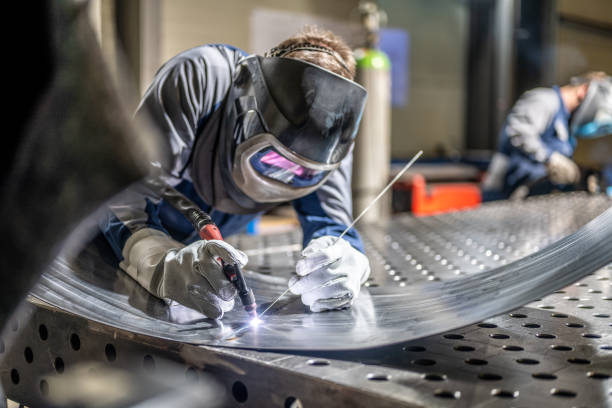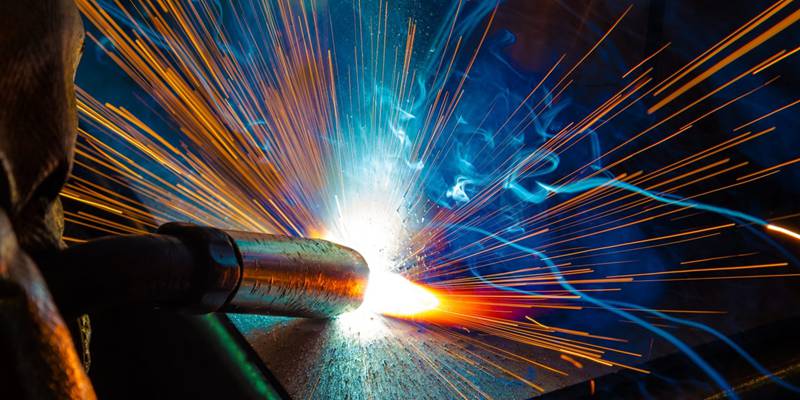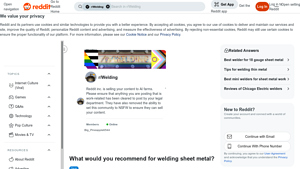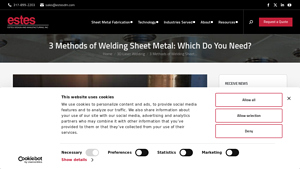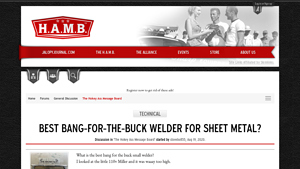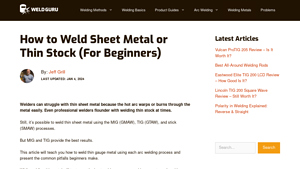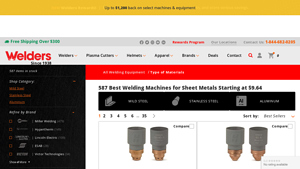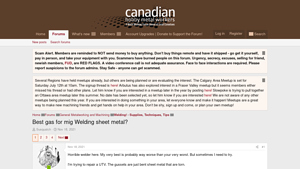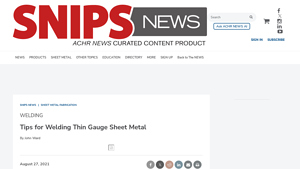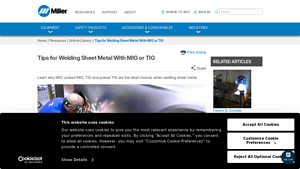Best Welding For Sheet Metal Guide: Type, Cost, Top List…
Introduction: Navigating the Global Market for best welding for sheet metal
Navigating the complexities of sourcing the best welding solutions for sheet metal can be a daunting challenge for international B2B buyers. Whether you are based in Africa, South America, the Middle East, or Europe, understanding the nuances of welding techniques like MIG, TIG, and laser welding is essential to ensure optimal production efficiency and quality. This comprehensive guide delves into various welding methods, their applications, and the considerations that influence material selection, ensuring you make well-informed decisions for your business needs.
In addition to providing insights into different welding processes, the guide also addresses critical factors such as supplier vetting, cost analysis, and the latest technological advancements in welding equipment. By equipping buyers with actionable knowledge, this resource aims to empower companies to enhance their operational capabilities while maintaining high standards of quality and performance. As global markets continue to evolve, having a thorough understanding of the best welding practices will not only streamline your procurement process but also position your business for sustainable growth in an increasingly competitive landscape. Explore the intricacies of welding for sheet metal and transform your sourcing strategy with confidence.
Understanding best welding for sheet metal Types and Variations
| Type Name | Key Distinguishing Features | Primary B2B Applications | Brief Pros & Cons for Buyers |
|---|---|---|---|
| MIG Welding | Fast, user-friendly, uses a continuous wire electrode | Automotive, HVAC, general metal fabrication | Pros: High production rate, versatile material use. Cons: Less precise, limited outdoor use. |
| TIG Welding | High precision, clean aesthetic, uses non-consumable electrode | Aerospace, artistic metalwork, thin materials | Pros: Superior control, minimal post-weld cleanup. Cons: Slower, requires skilled operators. |
| Laser Welding | Concentrated heat source, minimal thermal distortion | Electronics, medical devices, automotive parts | Pros: High speed, small weld seams. Cons: High equipment cost, requires precise fit-up. |
| Spot Welding | Localized heat, fast process, ideal for thin materials | Sheet metal assemblies, automotive manufacturing | Pros: Fast and efficient, low cost. Cons: Limited to overlapping joints, less versatile. |
| Plasma Welding | High heat and speed, uses ionized gas for welding | Aerospace, heavy machinery, thick materials | Pros: Excellent for thick materials, deep penetration. Cons: More complex setup, higher operational costs. |
What Are the Characteristics of MIG Welding for Sheet Metal?
MIG welding, or Metal Inert Gas welding, is characterized by its ability to deliver high production rates, making it ideal for large-scale manufacturing in industries such as automotive and HVAC. This method uses a continuous wire electrode, which is fed through a welding gun, allowing for quick and efficient welding of various metals, including mild steel, stainless steel, and aluminum. Buyers should consider the operational environment, as MIG welding is less effective outdoors due to wind affecting the shielding gas.
How Does TIG Welding Stand Out in Precision Applications?
TIG welding, or Tungsten Inert Gas welding, is renowned for its precision and clean welds, making it a preferred choice for applications that require high aesthetic quality, such as aerospace and artistic metalwork. This method employs a non-consumable tungsten electrode and allows for the use of filler materials, providing control over the weld pool. While it accommodates a range of material thicknesses, buyers must note that TIG welding typically requires more skill and is slower than MIG, making it essential to evaluate labor capabilities when considering this option.
What Are the Advantages of Laser Welding for Modern Applications?
Laser welding utilizes a focused laser beam to melt materials, resulting in minimal thermal distortion and precise welds. This method is particularly beneficial in high-tech industries such as electronics and medical devices, where small, accurate welds are crucial. Its speed and efficiency reduce overall production time, but the initial investment in laser welding equipment can be significant. B2B buyers should assess their production needs and budget when evaluating laser welding solutions, especially considering the requirement for close part fit-up.
Why Is Spot Welding Common in Sheet Metal Assemblies?
Spot welding is a fast and efficient method that applies localized heat to create welds, primarily used for thin sheet metal applications. This technique is prevalent in the automotive manufacturing sector, where speed and efficiency are paramount. While spot welding is cost-effective and quick, it is limited to overlapping joints, which may restrict its application in more complex assemblies. Buyers should evaluate their design requirements to determine if spot welding meets their production needs.
How Does Plasma Welding Benefit Heavy Industries?
Plasma welding is known for its ability to handle thick materials with deep penetration, making it suitable for heavy machinery and aerospace applications. This method uses ionized gas to create a high-temperature arc, allowing for versatile welding capabilities. However, the complexity of the setup and higher operational costs may deter some buyers. It’s essential for B2B purchasers to weigh the advantages of strong, deep welds against the potential for increased costs and training requirements for operators.
Key Industrial Applications of best welding for sheet metal
| Industry/Sector | Specific Application of best welding for sheet metal | Value/Benefit for the Business | Key Sourcing Considerations for this Application |
|---|---|---|---|
| Automotive Manufacturing | Joining body panels and structural components | Enhances structural integrity and safety of vehicles | Need for precision welding techniques like TIG or laser welding to maintain aesthetics and strength. |
| Aerospace | Fabrication of lightweight structures and components | Reduces weight, improving fuel efficiency and performance | High standards for weld quality and compliance with international aviation regulations are essential. |
| Construction | Fabrication of HVAC ducts and structural steelwork | Ensures durability and compliance with building codes | Consideration for material types and thickness, as well as speed of production to meet project timelines. |
| Electronics | Assembly of electronic enclosures and components | Provides protection against environmental factors | Requires high precision welding methods to avoid damage to sensitive components. |
| Energy (Oil & Gas) | Fabrication of pipelines and storage tanks | Ensures leak-proof and safe operation in harsh environments | Need for robust welding solutions that can withstand extreme conditions and materials. |
How Is Best Welding for Sheet Metal Utilized in Automotive Manufacturing?
In the automotive sector, best welding practices are crucial for joining body panels and structural components, ensuring vehicles meet safety standards. Techniques like MIG and TIG welding are preferred due to their efficiency and ability to produce aesthetically pleasing welds. International buyers should focus on sourcing equipment that provides high-speed production while maintaining weld integrity, particularly in regions with varying quality standards.
What Role Does Best Welding Play in Aerospace Applications?
Aerospace applications require precision welding for fabricating lightweight structures and components. The high-performance demands of this industry necessitate techniques such as TIG and laser welding, which offer excellent control and minimal thermal distortion. Buyers should prioritize suppliers who can meet stringent regulations and quality control measures, especially in regions like Europe where compliance is critical.
How Is Best Welding Applied in Construction Projects?
In the construction industry, best welding practices are essential for the fabrication of HVAC ducts and structural steelwork. Strong, durable welds ensure compliance with local building codes and enhance the longevity of structures. Buyers must consider the welding method suited for various material types and thicknesses, as well as production speed, to align with project timelines and budgets, particularly in emerging markets in Africa and South America.
Why Is Precision Important in Electronics Welding?
In electronics, best welding techniques are applied to assemble electronic enclosures and components, providing essential protection against environmental factors. The use of TIG welding is common due to its ability to create clean, precise welds without damaging sensitive components. Buyers should seek suppliers that specialize in high-precision welding to ensure product reliability, especially in competitive markets where quality assurance is paramount.
How Does Best Welding Benefit the Energy Sector?
The energy sector, particularly oil and gas, relies heavily on best welding practices for the fabrication of pipelines and storage tanks. These applications demand robust welding solutions that can withstand extreme environmental conditions and prevent leaks. International buyers must consider the durability of welding techniques and the materials used, ensuring compliance with safety standards that vary across regions, especially in the Middle East and Africa.
3 Common User Pain Points for ‘best welding for sheet metal’ & Their Solutions
Scenario 1: Navigating the Complexity of Welding Method Selection
The Problem: A B2B buyer in a manufacturing firm often faces confusion when selecting the appropriate welding method for sheet metal projects. With multiple options available—such as MIG, TIG, and laser welding—the decision can feel overwhelming. Each method has its unique advantages and limitations, which can lead to the risk of choosing an unsuitable technique that may compromise production speed, weld quality, or even material integrity. This complexity is further exacerbated by varying project requirements, such as different material types and thicknesses, which necessitate a tailored approach.
The Solution: To streamline the welding method selection process, buyers should start by conducting a comprehensive assessment of their project requirements. Key factors to evaluate include the type of metal (e.g., carbon steel, stainless steel, or aluminum), the thickness of the materials, desired weld appearance, and production speed. Establishing clear criteria will help in narrowing down the options. For instance, if high production rates are essential and aesthetics are less critical, MIG welding may be the best choice. Conversely, for projects demanding precision and a clean finish—such as automotive or aerospace applications—TIG welding may be preferable. Additionally, consulting with a welding expert or supplier can provide invaluable insights tailored to specific projects, ensuring the chosen method aligns with both operational capabilities and quality standards.
Scenario 2: Addressing the Skills Gap in Welding
The Problem: Many companies encounter difficulties due to a skills gap among their workforce, particularly in TIG welding, which requires a higher level of expertise compared to MIG welding. This skills deficiency can lead to inconsistent weld quality, increased rework, and ultimately, higher operational costs. As B2B buyers seek to improve their manufacturing processes, they realize that the lack of trained personnel can become a significant bottleneck in achieving production goals and maintaining product quality.
The Solution: To mitigate the skills gap, companies should invest in targeted training programs for their welding staff. Offering hands-on workshops and courses focused on both MIG and TIG welding techniques can significantly enhance the skill level of existing employees. Partnering with local vocational schools or training organizations can also provide access to specialized knowledge and resources. Furthermore, developing a mentorship program where experienced welders guide less experienced team members can foster a culture of continuous learning. This investment not only improves the overall quality of welds but also boosts employee morale and retention, creating a more efficient and skilled workforce capable of meeting the demands of complex welding projects.
Scenario 3: Managing Cost-Effectiveness and Equipment Investment
The Problem: B2B buyers often grapple with the challenge of balancing the initial investment in welding equipment against the long-term operational costs. High-quality welding machines, especially for methods like laser welding, can require significant capital outlay. Companies may hesitate to invest in advanced technologies due to concerns over cost versus performance, particularly when budgets are tight. This financial uncertainty can hinder their ability to adopt more efficient and precise welding methods that could ultimately lower production costs in the long run.
The Solution: To navigate this challenge, buyers should conduct a thorough cost-benefit analysis that includes both the initial investment and ongoing operational costs. This analysis should encompass factors such as energy consumption, maintenance requirements, and potential productivity gains. Additionally, exploring financing options such as leasing or renting equipment can reduce upfront costs while allowing access to the latest technology. Buyers should also consider the scalability of their operations; investing in versatile machines that can handle multiple welding processes can provide greater long-term value. Lastly, establishing relationships with reputable suppliers who offer maintenance and support services can further extend the life of the equipment, ensuring that the investment continues to yield benefits over time. By taking a strategic approach to equipment investment, companies can enhance their welding capabilities while maintaining budgetary control.
Strategic Material Selection Guide for best welding for sheet metal
What Are the Key Properties of Common Materials Used in Sheet Metal Welding?
When selecting materials for sheet metal welding, understanding the properties of each material is crucial for ensuring optimal performance and suitability for specific applications. Below, we analyze four common materials used in welding, focusing on their properties, advantages, disadvantages, and considerations for international buyers.
How Does Carbon Steel Perform in Welding Applications?
Key Properties: Carbon steel is known for its excellent weldability, high strength, and good ductility. It can withstand high temperatures and pressures, making it suitable for various applications, including automotive and construction.
Pros & Cons: The primary advantage of carbon steel is its cost-effectiveness and durability. It is widely available and easy to fabricate. However, it is prone to corrosion if not properly treated, which can limit its lifespan in harsh environments. Additionally, while it offers good weldability, improper welding can lead to warping or cracking.
Impact on Application: Carbon steel is compatible with a variety of media, making it suitable for structural applications. However, its susceptibility to rust means that protective coatings or treatments may be necessary for outdoor or corrosive environments.
Considerations for International Buyers: Buyers in regions like Africa and South America should be aware of local standards for carbon steel, such as ASTM A36 or equivalent. Compliance with these standards ensures the material meets safety and performance requirements.
What Are the Advantages of Stainless Steel in Welding?
Key Properties: Stainless steel is renowned for its corrosion resistance, high strength, and aesthetic appeal. It can withstand extreme temperatures and has a high resistance to oxidation, making it ideal for both structural and decorative applications.
Pros & Cons: The key advantage of stainless steel is its longevity and low maintenance requirements due to its resistance to corrosion. However, it is more expensive than carbon steel and requires skilled welders for proper handling. TIG welding is often preferred for stainless steel to achieve clean, aesthetically pleasing welds, which can slow production rates.
Impact on Application: Stainless steel is widely used in industries such as food processing, pharmaceuticals, and architecture due to its hygienic properties and appearance. Its compatibility with various media makes it versatile, but buyers must consider the specific grade of stainless steel for their applications.
Considerations for International Buyers: Compliance with standards such as ASTM A240 or DIN 1.4301 is essential for stainless steel applications. Buyers in Europe and the Middle East should also consider local regulations regarding food safety and hygiene.
How Does Aluminum Compare in Welding Applications?
Key Properties: Aluminum is lightweight, has excellent corrosion resistance, and offers good thermal and electrical conductivity. Its low density makes it ideal for applications where weight is a concern, such as in aerospace and automotive industries.
Pros & Cons: The main advantage of aluminum is its high strength-to-weight ratio, which allows for lighter structures without compromising strength. However, it can be challenging to weld due to its thermal conductivity and the formation of an oxide layer, which requires pre-welding cleaning. Additionally, aluminum welding often requires specialized equipment, increasing overall costs.
Impact on Application: Aluminum is compatible with various media, including corrosive environments, making it suitable for marine applications. However, its lower melting point compared to steel means that careful temperature control is essential during welding.
Considerations for International Buyers: Buyers should be aware of standards such as ASTM B209 for aluminum. In regions like Europe, compliance with EN 573 is crucial for ensuring material quality.
What Role Does Copper Play in Welding Applications?
Key Properties: Copper is known for its excellent electrical conductivity, thermal conductivity, and corrosion resistance. It is often used in electrical applications and plumbing.
Pros & Cons: The primary advantage of copper is its superior conductivity, making it ideal for electrical components. However, it is more expensive than other materials and can be difficult to weld due to its high thermal conductivity, which may require specialized techniques.
Impact on Application: Copper is compatible with various media, particularly in electrical and plumbing applications. However, its cost and welding challenges may limit its use in large-scale manufacturing.
Considerations for International Buyers: Compliance with standards such as ASTM B170 is essential for copper applications. Buyers should also consider the availability of skilled labor for welding copper, as it requires specialized techniques.
Summary Table of Material Selection for Welding
| Material | Typical Use Case for best welding for sheet metal | Key Advantage | Key Disadvantage/Limitation | Relative Cost (Low/Med/High) |
|---|---|---|---|---|
| Carbon Steel | Structural applications, automotive parts | Cost-effective and durable | Prone to corrosion | Low |
| Stainless Steel | Food processing, pharmaceuticals, architecture | Corrosion resistance and aesthetics | Higher cost and requires skilled welders | High |
| Aluminum | Aerospace, automotive, marine applications | Lightweight with high strength-to-weight ratio | Difficult to weld and requires special equipment | Medium |
| Copper | Electrical components, plumbing | Excellent conductivity | High cost and welding challenges | High |
This guide provides valuable insights for B2B buyers in selecting the most suitable materials for sheet metal welding, ensuring compliance with international standards and optimizing product performance.
In-depth Look: Manufacturing Processes and Quality Assurance for best welding for sheet metal
What Are the Key Stages in the Manufacturing Process for Welding Sheet Metal?
The manufacturing process for welding sheet metal involves several critical stages: material preparation, forming, assembly, and finishing. Each of these stages plays a vital role in ensuring that the final product meets quality and performance standards.
How is Material Prepared for Welding in Sheet Metal Fabrication?
Material preparation is the foundational step in welding sheet metal. It begins with the selection of appropriate materials, which can range from carbon steel to stainless steel or aluminum. Each material requires specific handling and processing techniques.
Before welding, the sheets must be cleaned to remove any contaminants like oil, rust, or dirt that could compromise the weld quality. Techniques such as sandblasting, chemical cleaning, or mechanical grinding are commonly employed. Additionally, the edges of the sheets may need to be beveled or machined to ensure proper fit-up during the welding process.
What Forming Techniques Are Commonly Used in Sheet Metal Welding?
Once the materials are prepped, the next step is forming. This stage may involve processes like bending, punching, or cutting to achieve the desired shapes and dimensions. The forming process can be critical, as it dictates how well the pieces will fit together during assembly.
Methods such as CNC (Computer Numerical Control) machining are often utilized for high precision in cutting and forming. This technology not only enhances accuracy but also increases efficiency, reducing waste and production time.
How is Assembly Conducted in Sheet Metal Welding Processes?
The assembly stage involves bringing together the prepared and formed components for welding. Accurate alignment is crucial here, as even minor misalignments can lead to structural weaknesses. In many cases, fixtures or jigs are used to hold the components in place during the welding process.
Depending on the chosen welding method—MIG, TIG, or laser welding—the setup will vary. For instance, MIG welding may require the use of a continuous wire electrode, while TIG welding necessitates a non-consumable tungsten electrode. Proper assembly ensures a strong bond and minimizes the risk of defects.
What Finishing Processes Are Essential After Welding?
After welding, the finishing stage involves cleaning and inspecting the welds. This may include grinding down any rough edges, applying protective coatings, or painting to enhance durability and aesthetics. The finishing process is essential, especially for products that will be exposed to harsh environmental conditions.
Post-weld heat treatment may also be necessary for certain materials to relieve stresses caused during the welding process. This step is crucial for maintaining the integrity of the weld and ensuring the longevity of the final product.
What Quality Assurance Standards Should B2B Buyers Consider in Welding?
Quality assurance (QA) is a critical aspect of the welding process, particularly for international B2B buyers. Understanding relevant international and industry-specific standards can help ensure that the products meet regulatory and performance requirements.
Which International Standards Are Relevant for Welding Quality Assurance?
ISO 9001 is one of the most recognized international standards for quality management systems. Adherence to this standard demonstrates a commitment to consistent quality and customer satisfaction. In addition to ISO 9001, industry-specific certifications such as CE (Conformité Européenne) for products sold in Europe, or API (American Petroleum Institute) standards for products used in the oil and gas industry, may also be applicable.
These standards often include guidelines for material selection, process control, and final inspections, ensuring that the welding process meets the necessary quality benchmarks.
What Are the Key Quality Control Checkpoints in Welding?
Quality control (QC) checkpoints are integral to maintaining high standards throughout the manufacturing process. These checkpoints typically include:
- Incoming Quality Control (IQC): Inspection of raw materials to ensure they meet specified standards before entering the production process.
- In-Process Quality Control (IPQC): Ongoing inspections during the welding process to identify and rectify any issues in real-time.
- Final Quality Control (FQC): Comprehensive inspections of the finished products to verify that they meet all specifications and quality standards.
Each of these checkpoints serves to identify potential issues early in the manufacturing process, reducing the likelihood of defects in the final product.
How Can B2B Buyers Verify Supplier Quality Control?
B2B buyers should take proactive measures to verify the quality control processes of potential suppliers. Here are some actionable strategies:
-
Conduct Audits: Regular audits of suppliers can help assess their compliance with quality standards and identify areas for improvement. This can include reviewing their quality management systems and production processes.
-
Request Reports: Suppliers should provide documentation of their quality control processes, including inspection reports and compliance certifications. This documentation can serve as evidence of their commitment to quality.
-
Third-Party Inspections: Engaging third-party inspection services can provide an unbiased assessment of a supplier’s quality control practices. These inspections can verify compliance with international standards and ensure that the products meet the required specifications.
What Are the Quality Control Nuances for International B2B Buyers?
For international B2B buyers, understanding the nuances of quality control in different regions is essential. Variations in regulations, standards, and practices can significantly impact the procurement process.
Buyers from Africa, South America, the Middle East, and Europe must be aware of regional standards and certifications that may differ from those in their home markets. Additionally, language barriers and cultural differences can affect communication about quality expectations. It is advisable to establish clear lines of communication and set explicit quality benchmarks to avoid misunderstandings.
By focusing on these key areas—manufacturing processes, quality assurance standards, checkpoints, and supplier verification—B2B buyers can make informed decisions that lead to successful partnerships in the welding of sheet metal.
Practical Sourcing Guide: A Step-by-Step Checklist for ‘best welding for sheet metal’
To assist B2B buyers in selecting the best welding solutions for sheet metal applications, this guide outlines a practical, step-by-step checklist. By following these steps, buyers can ensure they make informed decisions that align with their project requirements and quality standards.
Step 1: Define Your Technical Specifications
Begin by clearly outlining the technical specifications required for your welding project. Consider factors such as the type of materials (e.g., carbon steel, stainless steel, or aluminum), thickness, and any specific aesthetic requirements for the welds. This step is crucial because it sets the foundation for choosing the appropriate welding method—MIG, TIG, or laser welding—based on the material and application.
Step 2: Assess Welding Methods
Evaluate the different welding methods available and determine which aligns best with your project needs. MIG welding is ideal for high-speed production and thicker materials, while TIG welding offers precision and clean aesthetics for intricate designs. Understanding the strengths and weaknesses of each method will help you select the most effective option for your specific applications.
Step 3: Evaluate Potential Suppliers
Before making a purchase, thoroughly vet potential suppliers to ensure they meet your quality and service expectations. Request company profiles, case studies, and references from other buyers in similar industries or regions. This step is essential to confirm the supplier’s capability to deliver on technical specifications and timelines, as well as to assess their reputation in the market.
Step 4: Verify Certifications and Compliance
Ensure that the suppliers you consider have the necessary certifications and comply with industry standards. Look for certifications such as ISO 9001 for quality management and any relevant local or international welding standards. Compliance indicates a commitment to quality and can significantly reduce the risk of defects in your welding projects.
Step 5: Request Samples or Trial Runs
Whenever possible, request samples or trial runs of the welding services offered by potential suppliers. This allows you to evaluate the quality of their work firsthand and assess the appearance and strength of the welds. A trial run can also provide insights into the supplier’s operational efficiency and responsiveness to your requirements.
Step 6: Discuss Post-Weld Services
Inquire about any post-weld services the supplier may offer, such as cleaning, finishing, or inspection. These services can be critical in ensuring that the final product meets your quality standards and is ready for use or further processing. Understanding the complete service offering can enhance your overall experience and satisfaction with the supplier.
Step 7: Negotiate Terms and Conditions
Once you have selected a supplier, negotiate terms and conditions that align with your project requirements. Discuss pricing, delivery timelines, payment terms, and any warranties or guarantees on the work. Clear communication at this stage helps avoid misunderstandings and ensures a smooth working relationship throughout the project.
By following this checklist, B2B buyers can confidently navigate the sourcing process for welding solutions, ensuring they select the best options for their sheet metal projects.
Comprehensive Cost and Pricing Analysis for best welding for sheet metal Sourcing
What Are the Key Cost Components in Welding for Sheet Metal?
When considering the best welding solutions for sheet metal, several cost components come into play. Understanding these elements can help B2B buyers make informed decisions.
-
Materials: The choice of welding method significantly impacts material costs. For instance, MIG welding typically utilizes a solid wire electrode and shielding gas, while TIG welding employs a non-consumable tungsten electrode and may require additional filler materials. The type of base metal—be it carbon steel, stainless steel, or aluminum—also affects pricing. For example, aluminum may require pre-welding treatment to ensure a clean surface, which adds to material costs.
-
Labor: Labor costs vary based on the skill level required for the welding process. TIG welding, known for its precision, often demands more skilled labor, which can increase labor costs. Conversely, MIG welding is generally easier to learn, leading to lower labor costs. The complexity of the project and the required weld appearance can further influence labor pricing.
-
Manufacturing Overhead: Overhead costs encompass facility expenses, utilities, and equipment maintenance. Automated processes, such as robotic MIG welding, can reduce labor costs but may require significant upfront investment in machinery. The choice between manual and automated processes should align with production volume and budget constraints.
-
Tooling: Tooling costs include the equipment necessary for specific welding methods. For instance, laser welding requires precision machinery that can be costly. Buyers should factor in these expenses when evaluating different welding options, as the initial investment can impact the overall cost structure.
-
Quality Control (QC): Ensuring weld quality through inspections and certifications adds to the overall cost. Quality control measures are vital, especially for industries that demand high standards, such as aerospace or automotive. The level of scrutiny required will influence the QC budget.
-
Logistics: Transportation and storage of materials and finished products can incur additional costs. International buyers must also consider customs duties and tariffs, particularly when sourcing materials from different regions. Incoterms play a crucial role in determining who bears these costs.
-
Margin: Suppliers will typically include a margin in their pricing to cover risks and ensure profitability. Understanding the margin expectations of suppliers can provide insights into potential negotiation points.
How Do Price Influencers Affect Welding Costs for Sheet Metal?
Several factors influence pricing in the welding sector, particularly for international B2B buyers.
-
Volume/MOQ (Minimum Order Quantity): Larger orders often lead to lower per-unit prices due to economies of scale. Buyers should negotiate for bulk discounts, especially when dealing with suppliers in regions with competitive pricing.
-
Specifications and Customization: Custom specifications can increase costs due to the need for specialized materials or processes. Buyers should clearly communicate their requirements to avoid unexpected expenses.
-
Materials and Quality Certifications: The quality of materials and certifications required for specific industries can significantly influence pricing. Suppliers offering higher-grade materials or certifications may charge a premium.
-
Supplier Factors: Supplier reputation, location, and production capabilities can affect pricing. Established suppliers may command higher prices due to perceived reliability, while emerging suppliers might offer competitive rates to build market share.
-
Incoterms: Understanding the Incoterms associated with a transaction is essential. They dictate who is responsible for shipping, insurance, and tariffs, directly impacting the total cost.
What Buyer Tips Can Help Optimize Costs in Welding?
To maximize cost-efficiency in welding sheet metal, international buyers can consider the following strategies:
-
Negotiate Effectively: Leverage volume orders to negotiate better pricing. Establishing a long-term relationship with suppliers can also lead to favorable terms and discounts.
-
Evaluate Total Cost of Ownership (TCO): Consider not just the initial purchase price but also long-term costs associated with maintenance, operation, and potential downtime. A more expensive but higher-quality welding solution may offer better TCO.
-
Understand Pricing Nuances: Familiarize yourself with regional pricing differences, especially when sourcing from countries with varying labor and material costs. Understanding these nuances can aid in selecting the most cost-effective supplier.
-
Consult Industry Experts: Engaging with industry experts can provide valuable insights into best practices and emerging trends that may impact costs.
Disclaimer
The prices and cost structures discussed are indicative and may vary based on specific project requirements, regional differences, and market conditions. Always conduct thorough research and obtain quotes from multiple suppliers to ensure competitive pricing.
Alternatives Analysis: Comparing best welding for sheet metal With Other Solutions
Introduction to Welding Alternatives for Sheet Metal
In the realm of sheet metal fabrication, selecting the appropriate welding method is crucial for achieving the desired results in terms of strength, appearance, and cost-effectiveness. While various welding techniques exist, this section will explore the best welding for sheet metal and compare it with two viable alternatives: TIG (Tungsten Inert Gas) welding and laser welding. Each method offers distinct advantages and limitations that can significantly impact a business’s operations and product quality.
Comparison Table
| Comparison Aspect | Best Welding For Sheet Metal | TIG Welding | Laser Welding |
|---|---|---|---|
| Performance | High-speed with decent aesthetics | High precision and control | Very high speed, minimal distortion |
| Cost | Moderate initial investment | Higher equipment and operational costs | High initial investment, low operational costs |
| Ease of Implementation | User-friendly, quick setup | Requires skilled operators | Complex setup, requires precision machinery |
| Maintenance | Moderate, with regular checks | High, due to sensitive equipment | Low, with minimal wear and tear |
| Best Use Case | General fabrication, high volume | Aesthetic and precision-focused applications | Precision parts, thin materials, and high-speed production |
Detailed Breakdown of Alternatives
TIG Welding
TIG welding, or Gas Tungsten Arc Welding, is renowned for its ability to produce clean, aesthetically pleasing welds. It offers high precision and control, making it ideal for applications where visual appeal is paramount, such as in artistic metalwork or high-end automotive components. However, the process is significantly slower than MIG welding, making it less suitable for high-volume production. Additionally, TIG welding requires a higher skill level, which can lead to increased training costs and a steeper learning curve for new operators.
Laser Welding
Laser welding employs a concentrated laser beam to melt and fuse materials with remarkable precision. This method is extremely fast and produces minimal thermal distortion, making it ideal for thin materials and intricate designs. The weld seams are typically very small, reducing the need for post-weld cleanup and allowing for immediate processing, such as painting. However, the initial investment in laser welding equipment can be substantial, and the complexity of the setup requires skilled technicians to operate and maintain the machinery. This can limit its accessibility for smaller businesses or those with budget constraints.
Conclusion: Choosing the Right Welding Solution for Your Needs
When considering the best welding for sheet metal, B2B buyers must assess their specific requirements, including production speed, material type, and desired weld aesthetics. Each welding method presents unique advantages and challenges, making it essential to align the choice with the operational goals and capabilities of the business. Factors such as initial investment, maintenance needs, and the skill level of the workforce should also influence the decision. By thoroughly evaluating these aspects, buyers can select the most appropriate welding solution that not only meets their immediate needs but also supports long-term operational efficiency and product quality.
Essential Technical Properties and Trade Terminology for best welding for sheet metal
What Are the Key Technical Properties for Effective Sheet Metal Welding?
In the realm of sheet metal welding, understanding essential technical properties is crucial for ensuring quality and efficiency in production. Here are some critical specifications to consider:
1. Material Grade
Material grade refers to the classification of the metal being welded, which impacts the welding process selection. Common grades include carbon steel, stainless steel, and aluminum. Each grade has distinct properties that influence factors such as weldability, corrosion resistance, and strength. For B2B buyers, selecting the appropriate material grade is vital to meet product specifications and performance requirements.
2. Tolerance
Tolerance defines the acceptable limits of variation in a physical dimension. In welding, tight tolerances are essential for ensuring that welded components fit together precisely. For instance, laser welding requires a gap of no more than 0.005 inches between parts. Adhering to specified tolerances minimizes the risk of defects and rework, thereby reducing costs and enhancing product reliability, which is particularly important for manufacturers targeting high-quality markets.
3. Weld Penetration
Weld penetration refers to the depth to which the weld metal enters the base material. It is critical for the strength and integrity of the weld. Insufficient penetration can lead to weak joints, while excessive penetration may cause warping or distortion. Understanding the necessary penetration levels for different materials and thicknesses helps B2B buyers ensure that their welding processes yield durable, high-quality products.
4. Heat Affected Zone (HAZ)
The Heat Affected Zone is the area surrounding the weld that experiences changes in microstructure due to heat exposure. The size and characteristics of the HAZ can influence the mechanical properties of the welded joint. Buyers must consider HAZ when selecting welding methods, especially for materials that are sensitive to heat, such as stainless steel, to avoid compromising the strength and performance of the final product.
5. Filler Material
Filler material is used to enhance the weld pool and add strength to the joint. The choice of filler material must match the base metals to ensure compatibility and optimal performance. Inadequate selection can lead to weak bonds and increased risk of failure. For buyers, understanding the role of filler materials in the welding process is essential for achieving the desired mechanical properties and aesthetics in the final product.
What Are the Common Trade Terms in Welding?
Familiarity with industry terminology is equally important for effective communication and decision-making in the welding sector. Here are some commonly used terms:
1. OEM (Original Equipment Manufacturer)
OEM refers to companies that produce parts or equipment that may be marketed by another manufacturer. In welding, OEMs often require specific welding standards and processes to ensure compatibility and quality. Understanding OEM requirements can help buyers align their sourcing strategies with industry expectations.
2. MOQ (Minimum Order Quantity)
MOQ indicates the smallest quantity of products that a supplier is willing to sell. In welding, MOQs can affect procurement strategies and inventory management. Buyers need to negotiate MOQs to optimize costs while ensuring they have enough materials for production without overstocking.
3. RFQ (Request for Quotation)
An RFQ is a formal document that solicits price quotes from suppliers for specific products or services. In the context of welding, issuing an RFQ allows buyers to compare costs and services from multiple vendors, facilitating informed purchasing decisions. Understanding how to craft an effective RFQ is crucial for securing favorable terms.
4. Incoterms (International Commercial Terms)
Incoterms are a set of international rules that define the responsibilities of buyers and sellers in shipping goods. These terms clarify who is responsible for shipping costs, insurance, and risk during transport. Familiarity with Incoterms is essential for B2B buyers engaged in cross-border transactions, ensuring compliance and reducing potential disputes.
5. WPS (Welding Procedure Specification)
WPS is a document that describes the welding process, materials, and techniques to be used for a specific project. It serves as a guideline to ensure consistency and quality in welding operations. Buyers must understand the importance of WPS to ensure that their welding practices meet industry standards and project requirements.
By grasping these essential properties and terms, B2B buyers can navigate the complexities of sheet metal welding with greater confidence, ensuring they make informed decisions that enhance their operational efficiency and product quality.
Navigating Market Dynamics and Sourcing Trends in the best welding for sheet metal Sector
What Are the Current Market Dynamics and Key Trends in the Best Welding for Sheet Metal Sector?
The global welding market for sheet metal is witnessing significant transformations driven by technological advancements, changing customer demands, and regional market dynamics. Key trends include the increasing adoption of automation and robotics in welding processes. This shift not only enhances productivity but also ensures consistent quality, which is crucial for industries ranging from automotive to aerospace. In regions such as Europe and the Middle East, where manufacturing precision is paramount, technologies like laser welding are becoming increasingly favored due to their speed and reduced thermal distortion.
Moreover, emerging markets in Africa and South America are experiencing a surge in demand for efficient and cost-effective welding solutions. This demand is largely fueled by infrastructure development and a growing manufacturing base. As these regions modernize their industries, B2B buyers are actively seeking partnerships with suppliers who can offer advanced welding technologies and reliable support services.
Another noteworthy trend is the shift towards hybrid welding methods that combine different techniques, such as MIG and TIG, to optimize results for various applications. This versatility allows manufacturers to meet diverse project requirements while maintaining efficiency and quality. As international buyers navigate these dynamics, understanding local market conditions and technological capabilities will be vital for informed sourcing decisions.
How Are Sustainability and Ethical Sourcing Addressed in the Welding Industry?
As global awareness of environmental issues grows, sustainability and ethical sourcing have become integral to the welding industry. The environmental impact of traditional welding processes, including high energy consumption and emissions, has prompted manufacturers to seek greener alternatives. Innovations such as low-energy welding technologies and the use of renewable energy sources are gaining traction, significantly reducing the carbon footprint associated with welding operations.
Ethical sourcing is also becoming a priority for B2B buyers. This involves not only the selection of materials that meet sustainability criteria but also ensuring that the entire supply chain adheres to ethical practices. Certifications such as ISO 14001 for environmental management and compliance with local labor laws are increasingly demanded by conscientious buyers. By prioritizing suppliers with these certifications, businesses can enhance their reputation and appeal to environmentally conscious consumers.
Furthermore, the use of recycled materials in welding applications is on the rise. This trend not only helps reduce waste but also aligns with the principles of a circular economy. Buyers are encouraged to inquire about the sustainability credentials of their suppliers and to consider materials that contribute to a more sustainable welding practice.
What Is the Brief Evolution and History of Welding Techniques Relevant to B2B Buyers?
The evolution of welding techniques has significantly shaped the manufacturing landscape, particularly in sheet metal fabrication. Historically, welding has transitioned from primitive methods, such as forge welding in ancient times, to the sophisticated processes we see today. The introduction of electric arc welding in the early 20th century marked a pivotal moment, enabling faster and more efficient metal joining.
By the mid-20th century, advancements such as MIG and TIG welding revolutionized the industry, providing greater versatility and control. These methods became essential in sectors requiring high precision and durability, such as aerospace and automotive manufacturing. The late 20th century saw the advent of laser welding, which introduced a new level of speed and accuracy, further enhancing production capabilities.
Today, the welding sector continues to innovate, with ongoing research into hybrid techniques and automation. For B2B buyers, understanding this historical context is crucial for making informed decisions regarding the best welding practices and technologies that align with their operational needs and sustainability goals. As the industry evolves, staying abreast of these changes will help businesses maintain a competitive edge in a rapidly changing market.
Frequently Asked Questions (FAQs) for B2B Buyers of best welding for sheet metal
-
How do I solve issues with weld quality in sheet metal fabrication?
To address weld quality issues, start by ensuring that the material is clean and free from contaminants like oil, rust, or dust. Select the appropriate welding method based on the materials used; for example, MIG welding is suitable for thicker materials, while TIG welding offers precision for thinner sheets. Regularly maintain and calibrate your equipment to prevent defects caused by faulty machinery. Finally, conduct routine inspections and testing of welds to identify any inconsistencies early in the process, allowing for timely adjustments. -
What is the best welding method for sheet metal?
The best welding method for sheet metal largely depends on the specific requirements of your project. MIG welding is often favored for its speed and efficiency, making it ideal for high-volume production. Conversely, TIG welding is preferred when aesthetics and precision are critical, especially for stainless steel applications. Laser welding offers unique advantages in terms of speed and minimal heat distortion, suitable for high-precision tasks. Assess factors like material type, thickness, and the desired weld appearance to make an informed decision. -
What are the key factors to consider when choosing a welding supplier?
When selecting a welding supplier, consider their experience and expertise in the specific welding methods relevant to your projects. Evaluate their quality assurance practices, including certifications like ISO, which ensure compliance with international standards. Look for suppliers who can provide custom solutions tailored to your needs and have a reliable supply chain for timely deliveries. Lastly, assess their customer service and support capabilities, as effective communication is crucial in addressing any issues that may arise during production. -
What are the minimum order quantities (MOQs) for welding materials?
Minimum order quantities can vary significantly depending on the supplier and the type of welding materials required. For bulk orders, suppliers often have set MOQs to ensure cost-effectiveness in production and logistics. It’s advisable to discuss your specific needs with potential suppliers to negotiate MOQs that align with your project requirements. Additionally, some suppliers may offer flexible options for smaller projects or prototypes, so inquire about their policies to find a suitable arrangement. -
How can I ensure compliance with international trade regulations when sourcing welding materials?
To ensure compliance with international trade regulations, familiarize yourself with the specific import/export laws of your country and the countries of your suppliers. Verify that your suppliers are compliant with necessary certifications and standards, such as CE marking in Europe or ASTM standards in the U.S. Maintain clear documentation of all transactions, including invoices and shipping documents, to facilitate smooth customs clearance. Additionally, consider working with a freight forwarder or customs broker who can provide expertise in navigating international shipping regulations. -
What payment terms are typical in B2B welding material transactions?
Payment terms can vary, but common practices include net 30 or net 60 days from the invoice date, allowing buyers time to assess the quality of received materials. Some suppliers may require an upfront deposit, especially for custom orders or larger quantities. It’s essential to negotiate terms that align with your cash flow and project timelines. Additionally, consider using secure payment methods like letters of credit or escrow services to protect both parties in high-value transactions. -
How do I assess the quality assurance practices of a welding supplier?
To evaluate a welding supplier’s quality assurance practices, request documentation of their quality control processes, including any certifications like ISO 9001. Inquire about their testing methods, such as non-destructive testing (NDT) or weld inspections, to ensure compliance with industry standards. Review customer testimonials and case studies to gauge their reliability and consistency in delivering high-quality products. Additionally, consider visiting their facility to observe their operations and quality control measures firsthand. -
What logistics considerations should I keep in mind when sourcing welding materials?
When sourcing welding materials, consider the logistics of shipping, including lead times, transportation methods, and potential tariffs or duties. Assess the location of your suppliers in relation to your operations to minimize shipping costs and delays. Ensure that your supplier has a reliable logistics partner to handle transportation and customs clearance efficiently. Additionally, plan for contingencies in case of supply chain disruptions, such as alternative suppliers or stockpiling critical materials to maintain production continuity.
Important Disclaimer & Terms of Use
⚠️ Important Disclaimer
The information provided in this guide, including content regarding manufacturers, technical specifications, and market analysis, is for informational and educational purposes only. It does not constitute professional procurement advice, financial advice, or legal advice.
While we have made every effort to ensure the accuracy and timeliness of the information, we are not responsible for any errors, omissions, or outdated information. Market conditions, company details, and technical standards are subject to change.
B2B buyers must conduct their own independent and thorough due diligence before making any purchasing decisions. This includes contacting suppliers directly, verifying certifications, requesting samples, and seeking professional consultation. The risk of relying on any information in this guide is borne solely by the reader.
Top 9 Best Welding For Sheet Metal Manufacturers & Suppliers List
1. Eastwood – 250 MIG Welder Recommendations
Domain: reddit.com
Registered: 2005 (20 years)
Introduction: Eastwood 250 MIG welder, capable of handling 1/8th to 1/4 inch material, user seeking recommendations for a welder better suited for 18 gauge sheet metal work. Suggestions include using .025 wire, adjusting amps and wire speed, and considering a TIG welder for better results.
2. Metalworks HP – MIG Welding Solutions
Domain: metalworkshp.com
Registered: 2001 (24 years)
Introduction: MIG Welding: Also called Gas Metal Arc Welding (GMAW), uses a continuous solid wire electrode fed through a welding gun. Pros: High production rate, ease of use, versatility in materials (mild steel, stainless steel, aluminum). Cons: Limited outdoor use, less precise than TIG welding, higher equipment cost. TIG Welding: Also known as Gas Tungsten Arc Welding (GTAW), uses a non-consumable tungsten …
3. Estes DM – Welding Methods & Solutions
Domain: estesdm.com
Registered: 2000 (25 years)
Introduction: Methods of Welding Sheet Metal: MIG (Metal Inert Gas), TIG (Tungsten Inert Gas), Laser Welding. MIG: Uses continuous solid wire electrode, suitable for carbon steels, stainless steel (Pulse MIG), and aluminum (Pulse MIG with special assist gas). Speed: Manual 30″/min, robotic increases throughput. TIG: Non-consumable tungsten electrode, slower speeds (7″-15″/min), preferred for stainless steel and…
4. Miller – 140 Welder, Hobart – Handler 140, Forney – Versatile 220V Welder
Domain: jalopyjournal.com
Registered: 1997 (28 years)
Introduction: 1. Miller 140 – 110 volt welder, considered high quality but expensive. 2. Hobart Handler 140 – suitable for 18 ga up to 3/16″ and almost 1/4″, priced around $500. 3. Forney welder – 220 volt, setup for MIG, stick, flux core, and potential for TIG with additional investment. Priced at $700 for a display model, retailing for $1100. 4. Esab welder – smaller and lighter components, experienced issues…
5. Weld Guru – MIG & TIG Welding Essentials
Domain: weldguru.com
Registered: 2006 (19 years)
Introduction: MIG Welding (GMAW): Use small diameter wires (0.023, 0.024, 0.030) for thin materials; avoid 100% CO2 shielding gas; best gas mixture is 75% argon and 25% CO2; push weld instead of pulling; avoid flux-cored wires. TIG Welding (GTAW): Use small diameter tungsten electrodes (0.020, 0.040, 1/16); grind tungsten to a sharp point; use ER70S-2 filler metal or silicon bronze; use pure argon shielding gas…
6. Welder Supply – Best Welding Machines for Sheet Metals
Domain: weldersupply.com
Registered: 1998 (27 years)
Introduction: 587 Best Welding Machines for Sheet Metals for sale starting from $9.64. Types of welding machines include MIG, TIG, Stick, Multi-Process, Engine Driven, and Submerged Arc Welders. Brands available are Miller, Hypertherm, Lincoln, ESAB, Forney, Hobart, and more. Payment options include Buy Now, Pay Later with low payments over 6, 18, or 24 months. Free shipping on orders over $300. Rewards program…
7. EasyMig – Best Gas for MIG Welding
Domain: canadianhobbymetalworkers.com
Registered: 2015 (10 years)
Introduction: Best gas for MIG welding sheet metal: 75/25 CO2/Argon recommended. Equipment: EasyMig 180 welder with pressure gauge and fittings. Adapters or flow gauge may be needed, but existing setup should work fine. Suggested practices: use small diameter wire, adjust voltage and wire speed, and practice on scrap metal to avoid burn through.
8. ACHR News – Welding Techniques and Processes
Domain: achrnews.com
Registered: 1999 (26 years)
Introduction: Welding Processes: MIG and TIG are recommended for welding thin sheet metal due to better heat control. Stick welding is possible but harder to master. Pulse welding is an advanced variation that helps avoid defects. Techniques: Skip welding and tack welding are suggested to minimize heat build-up and distortion. MIG Wire: Use the smallest wire diameter possible (0.023 for most applications, 0.030…
9. Miller – Multimatic® 220 AC/DC Multiprocess Welder
Domain: millerwelds.com
Registered: 1996 (29 years)
Introduction: Multimatic® 220 AC/DC Multiprocess Welder: AC/DC TIG, MIG, flux-cored, and stick welder featuring QuickTech™. 120V or 240V input power. Dynasty® 210 TIG Welders: A perfect combination of sophisticated inverter technology and advanced features, offering the most…
Strategic Sourcing Conclusion and Outlook for best welding for sheet metal
In the realm of sheet metal welding, selecting the appropriate method—whether MIG, TIG, or laser welding—can significantly impact production efficiency, cost-effectiveness, and overall weld quality. For B2B buyers, understanding the nuances of these techniques is essential. MIG welding offers high production rates and versatility across various materials, making it ideal for large-scale operations. In contrast, TIG welding excels in precision and aesthetic quality, suitable for specialized applications. Meanwhile, laser welding stands out for its speed and minimal post-weld cleanup, catering to high-precision needs.
Strategic sourcing plays a pivotal role in maximizing operational efficiency and minimizing costs. By aligning your sourcing strategies with the right welding technology, you can enhance product quality and ensure sustainable supply chain practices. As global markets continue to evolve, particularly in regions like Africa, South America, the Middle East, and Europe, the demand for advanced welding solutions will only grow.
Embrace the opportunity to refine your welding processes and strengthen your competitive edge. Connect with trusted suppliers and invest in the right technology to meet your unique needs. The future of sheet metal welding is bright, and your strategic choices today will shape the success of your projects tomorrow.
